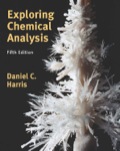
EBK EXPLORING CHEMICAL ANALYSIS
5th Edition
ISBN: 8220101443908
Author: Harris
Publisher: MAC HIGHER
expand_more
expand_more
format_list_bulleted
Question
Chapter 22, Problem 22.23P
Interpretation Introduction
Interpretation:
Reason behind the use of splitless injection with purge and trap sample preparation has to be explained.
Concept Introduction:
Splitless injection is very important injection technique for trace analysis in highly diluted sample. Spiltless injection has narrow injection band with solvent refocusing and cold trapping. By this injection method, loss of analyte can be prevented at the time of injection it into column.
Expert Solution & Answer
Want to see the full answer?
Check out a sample textbook solution
Students have asked these similar questions
. Each of the following compounds can be prepared by a mixed aldol condensation reaction. Give the
Cructures of the aldehyde and/or ketone precursors for each aldol product and formulate the reaction.
0
CH=CHCCH
3.
Ph
1
. Consider the reaction below to answer the following question:
H
NaOEt
H
BOH
بلی
H
+ H₂O
A. Write the complete stepwise mechanism for the reaction above. Show all intermediate structures
and all electron flow with arrows.
B. This reaction is an example of:
an intramolecular aldol condensation
a.
an intramolecular Claisen condensation
b.
C.
d.
a Robinson annulation
a Michael reaction
C. The product of this reaction is:
a.
b.
C.
d.
a ẞ. y-unsaturated aldehyde
an a, B-unsaturated ketone
an a, B-unsaturated aldehyde
an enol
Classify each of the following nitrogen atoms in the following compounds as primary, secondary,
tiary, or quaternary.
A.
B.
C.
CH3
HO-CHCHNHCH3
ephedrine
CH CHCH3 amphetamine
NH₂
D.
CF
H3C CH3
mapiquat chloride
HO
fexofenadine
OH
H3C
CH3
CO₂H
Chapter 22 Solutions
EBK EXPLORING CHEMICAL ANALYSIS
Ch. 22 - Prob. 22.1PCh. 22 - Prob. 22.2PCh. 22 - Prob. 22.3PCh. 22 - Prob. 22.4PCh. 22 - Prob. 22.5PCh. 22 - Prob. 22.6PCh. 22 - Prob. 22.7PCh. 22 - Prob. 22.8PCh. 22 - Prob. 22.9PCh. 22 - Prob. 22.10P
Ch. 22 - Prob. 22.11PCh. 22 - Prob. 22.12PCh. 22 - Prob. 22.13PCh. 22 - Prob. 22.14PCh. 22 - Prob. 22.15PCh. 22 - Prob. 22.16PCh. 22 - Prob. 22.17PCh. 22 - Prob. 22.18PCh. 22 - Prob. 22.19PCh. 22 - Prob. 22.20PCh. 22 - Prob. 22.21PCh. 22 - Prob. 22.22PCh. 22 - Prob. 22.23PCh. 22 - Prob. 22.24PCh. 22 - Prob. 22.25PCh. 22 - Prob. 22.26PCh. 22 - Prob. 22.27PCh. 22 - Prob. 22.28PCh. 22 - Prob. 22.29P
Knowledge Booster
Similar questions
- .. Name each of the following compounds by IUPAC rules. [three Only] A. 0 B. C. Cl NH₂ OCH N CH3 NHCH2CH3 D. CH O₁₂N NH₂arrow_forwardDraw the structure of the aldol self condensation product for each of the following compounds if a compound does not under go aldol self condensation explain whyarrow_forwardIndicate how the addition of a nucleophile :NuH2 to a ketone R-CO-R occurs.arrow_forward
- Indicate the compound that gives us a primary carbocation and that gives us a secondary carbocation: R-CHO and R-CO-Rarrow_forwardDraw a stepwise mechanism for the following reaction. OHarrow_forwardHelp with annotating the labeled peaks in the 'H NMR (solvent CDCls) spectra and 'H NMR (solvent Acetone-D6) spectra Also help with Calculating the keto-enol tautomerization Ka constant for the product in both solvents.Two solvents and two different Kaarrow_forward
- Draw a Haworth projection of a common cyclic form of this monosaccharide CH₂OH HO H HO H H OH CH₂OHarrow_forwardCan you explain how I get these here and show the steps plz?arrow_forwardGive the IUPAC name for this compound Hydrocarbon Condensed Formulas Hint C2H5 CH2CH3 expand that in all the formula Part A: (CH3)2CHCH(C2H5)CH2CH2CH3 Give the IUPAC name for this compound. Part B: CH2=C(C2H5)CH2CH2CH3 Give the IUPAC name for this compound. Part C: (CH3)2C=CHC(C2H5)=CH2 Give the IUPAC name for this compound. Part D: CH3C=CCH(C2H5)2 Give the IUPAC name for this compound. Part E: (CH3)3CC=CCH2CH=C(CH3)2arrow_forward
- Select/ Match the correct letter from the image below for the IUPAC names given below: A B C D 3 E F G H K L Part 1. 4-methylheptane For example.mmmm Answer Letter H _for part 1 Part 2. 2,4-dimethylhexane Part 3. 2,3-dimethylpentane Part 4. 2,2-dimethylhexane Part 5. 2-ethyl-1,1,3,3-tetramethylcyclopentane Part 6. 3-ethyl-2-methylpentanearrow_forwardCan u show the process as to how to get these?arrow_forwardSketch the expected 'H NMR spectra for the following compound. Label all of the H's in the structure and the corresponding signal for the spectra you sketch. Make sure you include the integration value and the splitting pattern for each signal Indicate how many signals you would expect in the 13C NMRarrow_forward
arrow_back_ios
SEE MORE QUESTIONS
arrow_forward_ios
Recommended textbooks for you
 ChemistryChemistryISBN:9781305957404Author:Steven S. Zumdahl, Susan A. Zumdahl, Donald J. DeCostePublisher:Cengage Learning
ChemistryChemistryISBN:9781305957404Author:Steven S. Zumdahl, Susan A. Zumdahl, Donald J. DeCostePublisher:Cengage Learning ChemistryChemistryISBN:9781259911156Author:Raymond Chang Dr., Jason Overby ProfessorPublisher:McGraw-Hill Education
ChemistryChemistryISBN:9781259911156Author:Raymond Chang Dr., Jason Overby ProfessorPublisher:McGraw-Hill Education Principles of Instrumental AnalysisChemistryISBN:9781305577213Author:Douglas A. Skoog, F. James Holler, Stanley R. CrouchPublisher:Cengage Learning
Principles of Instrumental AnalysisChemistryISBN:9781305577213Author:Douglas A. Skoog, F. James Holler, Stanley R. CrouchPublisher:Cengage Learning Organic ChemistryChemistryISBN:9780078021558Author:Janice Gorzynski Smith Dr.Publisher:McGraw-Hill Education
Organic ChemistryChemistryISBN:9780078021558Author:Janice Gorzynski Smith Dr.Publisher:McGraw-Hill Education Chemistry: Principles and ReactionsChemistryISBN:9781305079373Author:William L. Masterton, Cecile N. HurleyPublisher:Cengage Learning
Chemistry: Principles and ReactionsChemistryISBN:9781305079373Author:William L. Masterton, Cecile N. HurleyPublisher:Cengage Learning Elementary Principles of Chemical Processes, Bind...ChemistryISBN:9781118431221Author:Richard M. Felder, Ronald W. Rousseau, Lisa G. BullardPublisher:WILEY
Elementary Principles of Chemical Processes, Bind...ChemistryISBN:9781118431221Author:Richard M. Felder, Ronald W. Rousseau, Lisa G. BullardPublisher:WILEY

Chemistry
Chemistry
ISBN:9781305957404
Author:Steven S. Zumdahl, Susan A. Zumdahl, Donald J. DeCoste
Publisher:Cengage Learning

Chemistry
Chemistry
ISBN:9781259911156
Author:Raymond Chang Dr., Jason Overby Professor
Publisher:McGraw-Hill Education

Principles of Instrumental Analysis
Chemistry
ISBN:9781305577213
Author:Douglas A. Skoog, F. James Holler, Stanley R. Crouch
Publisher:Cengage Learning

Organic Chemistry
Chemistry
ISBN:9780078021558
Author:Janice Gorzynski Smith Dr.
Publisher:McGraw-Hill Education

Chemistry: Principles and Reactions
Chemistry
ISBN:9781305079373
Author:William L. Masterton, Cecile N. Hurley
Publisher:Cengage Learning

Elementary Principles of Chemical Processes, Bind...
Chemistry
ISBN:9781118431221
Author:Richard M. Felder, Ronald W. Rousseau, Lisa G. Bullard
Publisher:WILEY